AUDIO-STUFF PART-1
Ask a question about this subject?
Post a question direct to our forums and get mailed when a reply is added!
There are 13 viewer comments posted to this page - Read

Author: admin
Date: 07-Apr-99
UUURRGGHH!... ANORAK TECH STUFF..... WELL, here's some stuff for newbies about SOUND & all that stuff.....
NAME DROPPING?
See...we have to get all this down, cos you wanna covered tha basics of a physical system, what all the basic bitz are, and how they fit in... but as you enter into this great world of home studio, all the terms and theories we need in order to work with equipment & get to grips with our new found music-making hobby, revolve around THESE fundamental rules, names/terms & principals, because of course, ALL terms of audio creation & audio electronics such as synthesis parameters, sampling etc, abide by these same names, laws and terms.
IN THE BEGINNING !
Sound is simply the movement of pressure waves through the air.... The pressure waves vibrate the tiny bones of the inner-ear... These vibrations are converted into tiny electrical brain-waves, which we percieve as sounds... The inner-ear uses the same principal as that of a microphone capturing sound-waves or a speaker playing them... it's the relationship between moving mechanical parts and air pressure waves... Naturally, in cases where the sound-waves are low in pitch, slow moving, and loud enuff, we can actually 'feel' the air pressure waves vibrating our body.... so we percive sound with a mixture of body parts...
RETURN TO SOURCE ?!
Start with the source... A snare drum hit with a stick !... the stick hits the skin which is taut over the drum head.. the skin vibrates and the vibrating skin pushes into the air creating pressure waves which move out and radiate away from the drum head & body...
So...'Pressure-waves' move outward radiating from the source.... To see this, chuck a stone into the pond in the park, or in the sink at home, and see how the waves created by the object dropping into the water radiate out from the source disturbance.... notice also, if doing this in a sink or confined vessel like a bowl, how the ripples/vibrations meet the edges, then bounce back, away from the walls... observing the ripples/waves in such a confined area, gives you some idea of how sound moves around inside an enclosed room, reflecting off walls etc.... Notice also, how larger stones or rocks create larger ripples spaced farther apart that smaller objects..
SOUND PROPERTIES
Ok... These pressure waves have certain properties...
'AMPLITUDE'... this is the volume, how loud it sounds how large the waves are... and,
'FREQUENCY'... how high or low in pitch it is... whether it is for example a bass-end sound, or higher sound, like a thin string sound...
FREQUENCY is the number of waves per second passing a given point, and is measured in HERTZ, after a geezer named Heirich R. Hertz, who set out a table to show how frequencies are related to cycles per second...
1 Kilo-hertz or 1000 hertz means the wave has 1000 cycles passing a given point per second....1Mhz or megahertz, is 1,000,000 cycles per second etc...
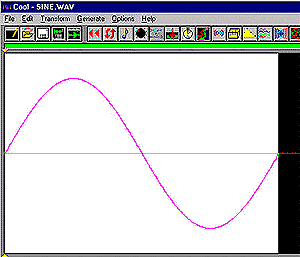
A single sine wave cycle
'Cycle' means the full cycle of one wavecycle from 0db/silence, to full on and back to off again... above is a single cycle of a sine wave... the center line being 0dB, silence...the wave height is the volume, and the left-to-right is the time....The 'Wavelength' is the distance from left to right..from peak-to-peak
Freqencies go further up into VHF (Very-High-Frequencies) & UHF (Ultra-High-Frequncies), as used in radio & TV signals etc, and beyond... Humans can hear a frequency-range, when young, of about 20 Hz to 20,000 Hz (20 Khz), which is the nominal frequency range for consumer cd's.... Our hearing deteriorates from about 12 years old onwards.... regular clubbing, or Napalm-Death gigs causes the top-end sensitivity of our hearing to deteriorate faster or to be totally destroyed...
ANORAK OR WHAT !!!?
So,,, sound has volume/amplitude...and frequency/pitch.... Also there is the time-based structure of the sound... How fast the sound reaches maximum volume... how long it lasts for and takes to die away until it is no longer audible... The most basic terms that can be used are:
ATTACK: The time it takes the sound wave/s to reach maximum amplitude or volume from silence....and...
DECAY: The time it takes the sound wave/s to die away to silence after reaching maximum amplitude/volume...
The characteristics of the sound's 'volume-over-time' shape is called it's 'AMPLITUDE-ENVELOPE'
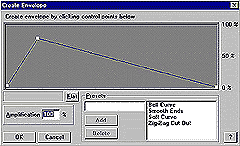
A simple envelope. The 'Attack' to reach max volume is not immeadiate. The sound then decays away gently...
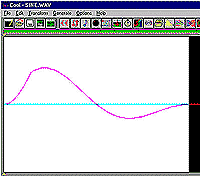
The result of applying the above amplitude/volume envelope to the SINE wave...
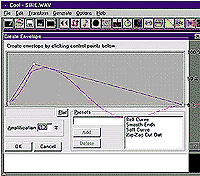
The envelope over the wave... See?!...
In real life, sounds are very complexed, and contain many frequencies layered over each other with different amplitude-envelopes...
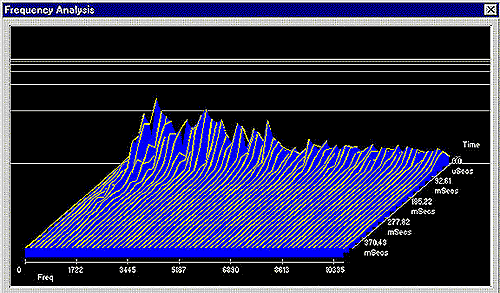
Here's a Frequency-time plot for a 909 Clap... The sound starts at the back of this plot, and moves forward to the front over time (marked along the right)... The peaks are the volumes/amplitudes of the different Frequencies composing the clap-sound... lowest/bass Frequencies to the Left, highest/treble to the Right.... The Clap's percussive amplitude characteristic is a 'fast attack'... with all frequencies attacking (rising) at about the same time at the beginning of the sound to reach maximum peak amplitude/volume very quickly...then a gradual 'Decay' with lower frequencies having the longest decay times.
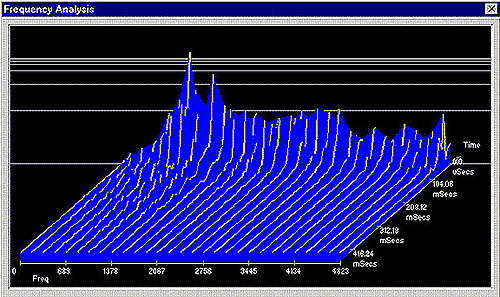
Here's a zoom-in on the lower end of the sound where all the energy is... The loudest party of the sound with the highest volume/Amplitude peaks is in the lower-mid range frequencies from 500 Hertz to about 1 Khz... these frequencies also decay longest too... higher up the frequency spectrum (right), the volume/Amplitude of the thinner, higher-pitched top-end overtones is lower in relation to the lower bass-end of the sound... The higher frequencies have less energy and die away faster with a faster 'DECAY' time to their amplitude-envelope.... so you can see how a sound is composed of many different frequencies all with different volumes/amplitude, attack & decay rates.
FUN-DA-MENTAL !!
Even tho a 'sound' may be composed of a multitude of different frequencies to create the overall sound character... what makes us hear that sound as a certain pitch, like with say a singer pitching a note for a melody ??... The dominant pitch/frequency is the 'Fundamental Frequency'....and is how we hear the sound in terms of it's pitch if any.
LENGTH??....
Frequency waves also have a length which is directly related to cycle (hertz) speed... this is called 'Wavelength'..... faster, higher sounds have shorter wavelengths.... You can see bass speakers move when playing low bass sounds.... tweeters move so fast to generate fast, short, hi-frequency cycles, that the tweeter's movement is imperceptible to the eye... the longer, larger bass-waves require a greater movement of the larger speaker-cone to push the wave forward from the cone....
HARMONICS
These are sometimes present in a sound along with the fundamental frequencies, and add to the sounds overall complexity, timbre, sweetness, warmth etc.... Harmonic frequencies, are simply mathmaticaly related frequency overtones based on divisions of the original fundamental frequency/pitch/tone...
Pluck a bass string on a guitar and look closely down it's length under a good light... you'll see the string vibrating.. You'll also see little peaks at intervals along it's length... why?... You pluck the string... the string vibrates, the waves travel up and down the string with a wave-cycle length set by the tuning/pitch of the string and the string length... The waves travelling in either direction up and down the string overlap and emphasize points along the wavelength at mathmatical divisions of the original length... at the halfway point for example, where the waves cross, they create an overtone wavelength HALF that of the original to create a harmonic overtone one octave above the fundamental !! .... divisions are standard as for sound/music... octaves can exist as 5th's 13ths etc.... SINE, SQUARE & SAWTOOTH waves have different amounts of harmonics...
SINE WAVES: They have no harmonics.. just the fundamental tone... they are the purest wave...
SQUARE WAVES: They have the fundamental tone or first partial, & then harmonic's going up in odd numbers from there....so (Fundamental)-Harm-1 - THEN - Harm-3 , Harm-5, Harm-7, Harm-9, Harm-11, Harm-13, Harm-15..
TRIANGLE WAVES: have again a Fundamental or first partial, & then harmonic's going up in odd numbers from there....so (Fundamental)-Harm-1 - THEN - Harm-3, Harm-5, Harm-7, Harm-9, Harm-11, Harm-13, Harm-15... same as a square, but the sound's different due to the shape
RESONANCE
Resonance is the act of Resonating... defined in the dictionary as "Re-sounding, echo-ing back etc"... basically, Resonance is used to describe a boosted peak or feedback-boost type emphasis of a particular frequency in a sound... On a synth, the resonance can be boosted... When applied to a played tone, it will add emphasis to the frequency selected by the filter cut-off control... (We'll come to filters later... they cannot be understood without this down)...
In objects, one or more frequencies will echo-back/feedback with more emphasis based on the internal volume, mass and construction materials of the object.... it is similar to feedback.
With a studio room, some audio frequency wavelengths will be exact multiples or divisions of that room's width or length... they are emphasised as they bounce back & forth off the opposing walls...because they can produce harmonic's at divisions of their wavelengths which are being emphasised by the room.... THOSE Frequencies that are emphasised by the room, are a room's resonance frequencies... yup... rooms have resonance too, JUST LIKE WITH THE HARMONIC'S ABOVE.... wavelengths blasting from the speakers will be travelling around the room..... harmonic's will be produced at frequencies that are divisions of the original Fundamental frequencies from the music.. (just like with a guitar string)......
Under normal circumstances we aren't to fussy about a rooms resonant charateristic's....But have you ever worked in a room, that emphasised sounds like a chair scraping??. (shool mostly)....the tonal quality of that honking-hollow-scraping sound is produced by the rooms characteristics of absorbing more of the other lesser heard frequencies.......
And ... thus people in studio's talk about 'Tuned' control rooms, where measures have been taken to remove any unpleasant resonant characteristics from a room to get an untainted room sound for mixing in where no frequencies are empahsised and the room has a reasonably flat response....This is usually done by firstly making no parallel facing walls, so that waves cannot bounce around after the actual audio event has occurred to much, and so that at louder volumes, harmonic's are reduced.... the other main thing is to build 'TRAPS' into the wall's &/or ceiling... BASS waves are long.... 100HZ IS 3.41 METERS LONG.... BASS-TRAPS allow the bass soundwaves to fall into these deep absorbing holes, thus breaking up their ability to resonate or produce harmonics by bouncing back & forth between even flat walls...
That is why if you have a bedroom studio & your music is loud, open the closet/cupbard... it may be resonating "".... stuff a matress in it vertically... HEY presto... a bass-trap.... etc etc....in fact, a large room working surrounded by antique door-less wardrobes stuffed with matteresses could be esthetically quite pleasing & trendy if they were fabric covered.... sorta 'Paisley-park' ma-a-a-a-n..... and it'd make a nice sound too i reckon....
So... quite alot there, but these characteristics/Terms crop-up in all areas of studio work... for example.. a turntable used in a club, has to be isolated from vibrations... and importantly, the actual deck has to be designed NOT to resonate at low frequencies... if it did, then it would start to vibrate at it's resonant frequency, and the vibrations would get down the arm & cartridge and sound like a mess....so a good turntable will be based around a solid plinth unit with no fundametal resonant characteristics....
Well, there is the raw basics.... Now if you like, read the AUDIO-STUFF PART-2, it's in the ARTICLES LIST ABOVE....
COMMENTS FOR:
'AUDIO-STUFF PART-1'There are a total: 13 comments posted to this page.
Name: --
Email:
Activity: Professional
Date: 07-Apr-99
---
| Article rating out of 5: |
Article 'ratings' were added September 2008, so most articles have no viewer rating
Name: TommyXie
Email:
Activity: Hobby-ist
Date: 09-Jul-99
I need some FM Synth information. Like
how to do FM Synth.
| Article rating out of 5: |
Article 'ratings' were added September 2008, so most articles have no viewer rating
Name: djo raver
Email:
Activity: Hobby-ist
Date: 31-Aug-99
cool article!!
| Article rating out of 5: |
Article 'ratings' were added September 2008, so most articles have no viewer rating
Name: Rafiul Islam
Email:
Website?: http://www2.astralscape.com
Activity: Hobby-ist
Date: 01-Dec-99
well, i just started getting into music making and stuff, basically for fun.. Great article for newbies loaded with info.
| Article rating out of 5: |
Article 'ratings' were added September 2008, so most articles have no viewer rating
Name: Jonathan Harris
Email:
Website?: http://members.theglobe.com/orgnalfire
Activity: Hobby-ist
Date: 22-Jun-00
your tutorials help the novices a lot. thanks for the help!
| Article rating out of 5: |
Article 'ratings' were added September 2008, so most articles have no viewer rating
Name: natural mann
Email:
Activity:
Date: 17-Jul-00
Question???
Can you direct me to software, or a hardware unit to tanspose the key of a song on a CD. I can change the pitch, the speed, now I need a device to change the key without changing the speed, (like that on a Karaoke machine)
thank you....Tony
| Article rating out of 5: |
Article 'ratings' were added September 2008, so most articles have no viewer rating
Name: sean
Email:
Activity: Professional
Date: 24-Jan-01
I am a professional engineer/producer
and I have many friends who dabble and
are always picking my brains for info
.... now all I do is point them in your
direction ......leaves me time to relax
after a hard day in the studio. all in
all a kewl resource and a great website
.... keep it
| Article rating out of 5: |
Article 'ratings' were added September 2008, so most articles have no viewer rating
Name: John
Email:
Activity: part-timer
Date: 29-Oct-03
Im looking for good speakers in the UK. I like Cerwin vega, but cant find a good range at decent prices.
What would be a good substitute for cerwin vega v152's?
thanks
John
| Article rating out of 5: |
Article 'ratings' were added September 2008, so most articles have no viewer rating
Name: Ryan
Email:
Activity: Professional
Date: 16-Dec-03
hi i was wondering if you could help me i am a student in colleg and i studdy electronics i have a deep intrest in audio electronics. im trying to buitl a 2way bass crossover but i cant find any curcuit diagrams do u know of any web sites i can have a look at
thanks
Ryan
| Article rating out of 5: |
Article 'ratings' were added September 2008, so most articles have no viewer rating
Name: Chris Casselman
Email:
Activity: Hobby-ist
Date: 17-Dec-04
how do you set up a car sub i got an 88watt amplifyer and a sub but i cant get the sub to work throgh the amplifyer
| Article rating out of 5: |
Article 'ratings' were added September 2008, so most articles have no viewer rating
Name: Chris
Email:
Website?: none
Activity: part-timer
Date: 07-Feb-06
Im using cubase sx3----ive just watched the excellent cubase tutorials----could you possibly release a mastering tutorial(including dithering, master comp, individual eq, etc)
That would be amazing
| Article rating out of 5: |
Article 'ratings' were added September 2008, so most articles have no viewer rating
Name: james PAK
Email:
Activity: part-timer
Date: 12-Jun-06
Hello, I'm just starting out in this field of 'live sound ' and I am looking for an actual audio download of 'hertz frequencies' so I can better familiarize myself with the that frequency when there is feedback at the monitors. Thank you James
| Article rating out of 5: |
Article 'ratings' were added September 2008, so most articles have no viewer rating
Last added comment
Name: suresh singh
Email:
Activity: part-timer
Date: 24-Mar-07
i wanna to know mathematical relationship between frequncy verces sound pressure level.
| Article rating out of 5: |
Article 'ratings' were added September 2008, so most articles have no viewer rating
'AUDIO-STUFF PART-1'
Note: To cut down on spammers, cookies must be enabled to post comments to this page.
[back to top]